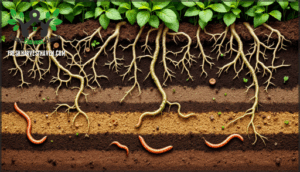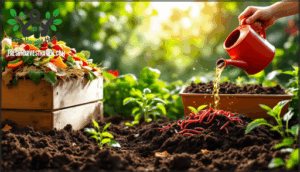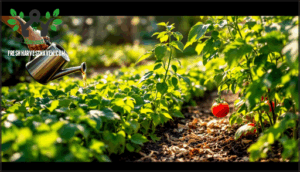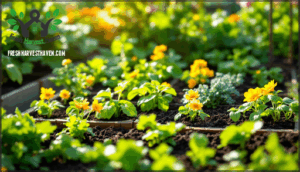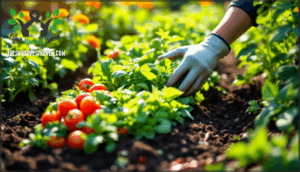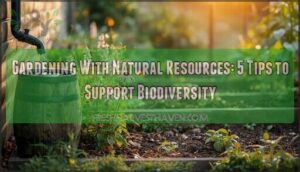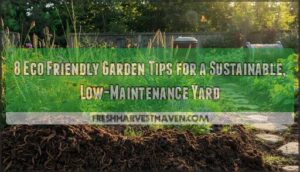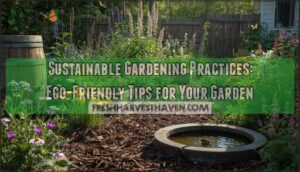This site is supported by our readers. We may earn a commission, at no cost to you, if you purchase through links.
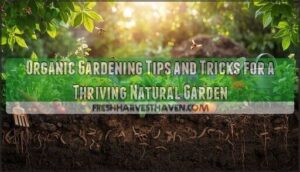
Organic gardening tips and tricks help you partner with these natural processes instead of fighting them. You’ll skip synthetic chemicals and instead nurture the living ecosystem beneath your feet.
Composting, companion planting, and smart pest management aren’t just buzzwords—they’re practical methods that transform your garden into a self-sustaining system. With the right approach, you’ll grow healthier produce while protecting the environment.
Table Of Contents
- Key Takeaways
- What is Organic Gardening?
- Building Healthy Organic Soil
- Selecting and Growing Organic Plants
- Natural Pest and Disease Management
- Maximizing Organic Garden Success
- Frequently Asked Questions (FAQs)
- How often should I water my organic garden?
- What organic fertilizers work best for vegetables?
- When is the best time to plant organically?
- How do I transition from conventional to organic?
- Which organic gardening tools are most essential?
- How much water do organic gardens need?
- When should I start my organic garden?
- Can I grow organic vegetables in containers?
- What organic fertilizers work best for tomatoes?
- How do I transition conventional soil to organic?
- Conclusion
Key Takeaways
- Organic gardening builds healthy soil through composting, organic matter, and supporting billions of microorganisms that naturally cycle nutrients and create resilient growing conditions without synthetic chemicals.
- Companion planting and crop rotation work together as natural pest defense systems—pairing complementary plants repels insects while rotating crop families annually prevents disease buildup and maintains soil fertility.
- Encouraging beneficial insects and birds through native plantings reduces pest pressure by up to 24%, creating balanced ecosystems where natural predators manage problems without pesticides.
- Strategic techniques like succession planting, vertical structures, and intensive spacing maximize yields in limited space while maintaining organic standards and extending harvest windows across multiple months.
What is Organic Gardening?
Organic gardening works with nature rather than against it. You’ll grow food and flowers without synthetic chemicals, relying instead on natural methods that build healthy soil and support beneficial organisms.
Understanding the core principles, how they differ from conventional approaches, and why they matter will help you create a thriving garden that’s better for you and the planet.
Key Principles and Practices
When you commit to organic gardening, you’re working with nature instead of against it—nurturing soil life, rotating crops, and building a system where plants defend themselves naturally.
You’ll focus on soil health through organic matter like compost, practice crop diversity to support biodiversity, and use natural fertilizers instead of synthetic chemicals.
These organic farming practices strengthen soil management while conserving water and creating resilient gardens.
Differences From Conventional Gardening
Organic and conventional gardening differ most in input restrictions—you won’t use synthetic fertilisers, pesticides, or GMOs in organic systems. Instead, organic farming methods rely on compost, crop rotation, and beneficial insects. Yield comparisons show organic crops average 19–25% lower output, though organic corn matched conventional yields after adjustment periods.
Soil management improves under organic farming practices, building carbon-rich soil. Conventional food production requires more energy from synthetic inputs, while the certification process guarantees organic standards through three-year adjustment phases and regular audits.
Organic agriculture prioritizes natural processes for fertility and pest management.
Benefits for Health and Environment
Beyond these farming differences, organic gardening delivers measurable health benefits and environmental protection. You’ll reduce pesticide exposure dramatically—organic produce contains up to 115 times less residue than conventional crops. Organic farming also strengthens sustainable agriculture through three key pathways: Organic farms use fewer synthetic pesticides.
- Pesticide Reduction shields you from toxic chemicals while supporting human wellness
- Soil Health improves through carbon sequestration and climate mitigation strategies
- Biodiversity Boost increases species richness by 30%, enriching local ecosystems
Your garden becomes a catalyst for positive change.
Building Healthy Organic Soil
Think of soil as a thriving community where billions of organisms work together to nourish your plants. Healthy organic soil isn’t just dirt—it’s a living ecosystem that needs the right balance of nutrients, structure, and biological activity.
Here’s how you build and maintain that foundation for your garden.
Understanding Soil as a Living Ecosystem
Think of soil as a bustling underground city—billions of bacteria, fungi, and earthworms work together to build the foundation of your organic garden. This soil food web drives nutrient cycling, with microbes releasing up to 90% of plant-available nitrogen annually. Your soil should contain about 5% organic matter to support microbial diversity and carbon sequestration. Living soil management focuses on soil health indicators like aggregate stability and biological activity, which maintain ecological balance.
| Soil Component | Role in Ecosystem | Impact on Plants |
|---|---|---|
| Bacteria & Fungi | Break down organic matter, release nutrients | Provide 80% of nutrient supply |
| Earthworms | Create channels, improve aeration | Increase water infiltration 2–5x |
| Mycorrhizal Fungi | Form partnerships with roots | Boost nutrient uptake in 80% of plants |
Composting and Vermicomposting Tips
Turning kitchen scraps and yard waste into garden gold doesn’t require a degree in soil science—just a few simple techniques and a little patience. You’ll want a balanced mix of compost materials—"greens" like vegetable scraps provide nitrogen, while "browns" like dried leaves add carbon.
For faster results, try vermicomposting benefits in a worm bin, where red wigglers transform kitchen waste into nutrient-rich fertilizer within weeks.
Brew compost tea to deliver beneficial microbes directly to plant roots, supporting organic farming methods that build organic matter in soil naturally.
Organic Soil Amendments and Mulching
Once your compost is working its magic, you can boost soil fertility even further with targeted amendments that feed both plants and the underground ecosystem they depend on. Green manure adds organic matter in soil, while biochar benefits include lasting carbon storage.
Apply compost tea as liquid fertilizer, or try soil solarization for pest control.
Choose mulch types—wood chips, straw, or leaves—to retain moisture and support organic farming methods that build resilient organic agriculture systems.
Selecting and Growing Organic Plants
Your plant choices set the foundation for organic success. Start with certified organic seeds and seedlings to avoid synthetic chemicals from the beginning.
The following strategies will help you select varieties wisely and arrange them for maximum productivity throughout the growing season.
Choosing Organic Seeds and Seedlings
Your plant selection starts long before the first sprout breaks through the soil—organic seeds and seedlings carry no synthetic coatings, chemical treatments, or genetically modified traits that can undermine your garden’s natural foundation. Look for certified organic seed packets with USDA verification, or explore heirloom varieties that preserve generations of natural resilience.
When seed starting indoors, choose untreated options from reputable suppliers. For seedling selection at local nurseries, confirm they’ve been grown using organic production methods without synthetic fertilizers or pesticides.
Companion Planting and Crop Rotation
Pairing the right plants together acts like assembling a natural defense team—certain combinations repel pests, boost growth, and protect soil nutrients season after season.
Try these beneficial pairings in your organic crops: For more advanced combinations and seasonal timing strategies, check out this summer garden companion planting guide that covers layout planning and pest-specific pairings.
- Tomatoes with basil—basil deters aphids while improving tomato flavor
- Carrots with onions—onions mask carrot scent from root flies
- Beans with corn—beans fix nitrogen, enriching soil health for heavy feeders
Rotate plant families yearly across different beds to prevent disease buildup and improve space in your organic food production system.
Planning Raised Beds and Layouts
A well-planned raised bed layout saves you time, maximizes yields, and makes organic gardening feel less like guesswork and more like working with nature’s blueprint.
Start with bed dimensions around 4 feet wide—you’ll reach the center without stepping on soil. Build beds 6–12 inches deep for most organic crops, deeper for root vegetables. Choose untreated wood or stone for material selection.
Position beds to capture morning sun and guarantee accessibility needs are met with pathways between rows. Enrich soil with organic matter in agriculture like compost before planting.
Beginner-Friendly Organic Crops
Starting with crops that practically grow themselves—like leafy greens, radishes, and bush beans—builds your confidence and gives you quick wins without demanding years of gardening know-how.
These low-maintenance veggies and quick-growing herbs like basil thrive in container-friendly crops settings, resist common pesticide problems, and provide fresh organic food production straight from your windowsill or raised bed.
Choose pest-resistant varieties to simplify your first season.
Natural Pest and Disease Management
Managing pests and diseases naturally doesn’t mean you’re defenseless—it means you work with nature instead of against it. Your organic garden thrives when you build a balanced ecosystem where beneficial creatures keep problems in check and healthy plants resist disease.
Natural pest control isn’t weakness—it’s working with nature to build an ecosystem where beneficial creatures and resilient plants defend themselves
Here’s how to protect your garden using methods that support both your plants and the environment.
Encouraging Beneficial Insects and Birds
Inviting native plant selection into your garden transforms it into a haven for beneficial creatures. Yards with at least 70% native plants boost reproductive success in insectivorous birds like chickadees.
These habitat feature boosts—hedgerows, brush piles, and diverse plantings—reduce pesticide use needs while enhancing biodiversity.
The ecosystem service effect is considerable: birds can reduce caterpillars by 24% within hours, naturally managing pests. Creating this environment aids animal welfare and protects your organic garden without chemicals.
Organic Pest Control Techniques
When beneficial visitors aren’t enough to keep pests in check, you can step in with hands-on organic methods that work with nature instead of against it. Handpicking larger pests, applying natural repellents like neem oil, and using organic pesticides such as insecticidal soap protect your crops without harmful environmental impact.
Regular pest monitoring lets you catch problems early, while beneficial predators continue their work. These farming methods safeguard consumer health and maintain ecological balance in your garden.
Preventing and Managing Plant Diseases
Keeping your organic garden disease-free starts with smart cultural practices. Rotate crop families each season to slash soil-borne pathogens by up to 90%. Space plants wider and prune for airflow—this lessens fungal problems considerably. Water early using drip systems instead of overhead sprinklers, and remove infected debris promptly.
Choose resistant varieties that reduce disease susceptibility and infectivity by half. These selections work beautifully in organic agriculture, slashing infection rates while avoiding synthetic pesticides.
Boost soil health with mature compost and organic amendments, which foster beneficial microbes that outcompete pathogens. Consider these biological controls:
- Apply Trichoderma or Bacillus-based biofungicides to reduce infections by 60–75%
- Use neem oil and garlic extracts as natural fungistatic treatments
- Sanitize tools between plantings to prevent cross-contamination
- Try soil solarization to decrease pathogen loads by over 80%
- Remove viral-infected tissues immediately to stop vector transmission
These farming methods protect both environmental impact and organic food quality while supporting the principles of sustainable organic agriculture.
Monitoring and Early Intervention
Catching problems before they spiral saves you from losing entire crops. Check your plants every few days, looking closely at leaf undersides, stems, and soil surface for early signs of trouble. Pest identification and disease symptoms guide your intervention thresholds.
Monitor weather patterns that trigger outbreaks, and test soil regularly to maintain environmental standards. This proactive approach in organic agriculture helps you apply natural pesticides only when needed, supporting sustainable food production.
Maximizing Organic Garden Success
Getting the most from your organic garden means working smarter, not harder. Strategic planting methods and proper timing can extend your harvest window and boost yields considerably.
Here’s how to make every square foot of garden space count while staying true to organic principles.
Succession Planting and Interplanting
You can stretch your harvest across months instead of facing a feast-or-famine cycle if you master succession planting and interplanting. Staggered planting means sowing fast-growing crops like lettuce every two weeks for a continuous harvest.
Interplanting pairs quick-maturing greens between slower crops like tomatoes, maximizing space optimization and yield maximization.
This organic practice standards approach improves resource efficiency while supporting sustainable food production methods that reduce the environmental impacts of organic agriculture.
Vertical and Intensive Gardening
Small spaces don’t mean small yields—vertical structures and intensive planting let you grow more food per square foot than traditional garden rows ever could. Here’s how you get the most from your organic food production without pesticides:
- Train vining crops upward using trellises to free up ground space for leafy greens below
- Plant intensively by spacing crops closer than conventional methods, following organic practice standards
- Choose compact varieties bred for small gardens, reducing environmental impacts of organic agriculture through space optimization
These vertical structures and intensive techniques deliver yield maximization while supporting sustainable food production.
Harvesting, Storing, and Preserving Produce
Timing your harvest right transforms months of organic care into peak-flavor food that stays fresh longer when you store and preserve it properly. Pick fruit and vegetables at their best harvest time—early morning works best when moisture levels peak. You’ll notice fewer pesticide residues in your organic food, making food safety simpler during food processing and storage.
| Storage Techniques | Extending Shelf Life |
|---|---|
| Cool, dark spaces for root vegetables | Blanch before freezing |
| Breathable bags for leafy greens | Dehydrate herbs and tomatoes |
| Counter ripening for tomatoes | Can high-acid produce |
These food preservation methods reduce food waste while maintaining the quality you’ve worked hard to grow.
Gardening in Challenging Conditions
Extreme weather doesn’t have to end your organic food production dreams—drought resilience starts when you build soil organic matter through compost and cover crops, which boost water retention by up to 20%. Heat management improves with mulching that cools roots naturally.
Flood control works better in organic systems because enhanced soil structure absorbs rainfall faster. Frost resilience develops through diversified planting that stabilizes soil temperatures.
Urban gardening succeeds even in contaminated spaces when you amend soil with compost, reducing chemical fertilizers and pesticide residues while creating productive growing zones.
Frequently Asked Questions (FAQs)
How often should I water my organic garden?
Generous watering depends on your soil type and plant needs. Sandy soils drain quickly and require more frequent irrigation than clay, which holds moisture longer. Check soil moisture an inch below the surface—if it’s dry, water deeply to encourage strong roots.
Weather impact matters too; hot spells increase demand while cooler days reduce it. Efficient irrigation in organic gardens mimics natural rainfall patterns. Most vegetables thrive with one to two inches weekly, adjusted for your specific conditions and organic certification standards.
What organic fertilizers work best for vegetables?
Compost tea and well-aged manure types deliver balanced nutrients for vegetables.
Bone meal boosts phosphorus for root development.
Green manure and cover crops enrich organic soil between seasons, supporting healthy food production with benefits of organic farming methods used on organic farms.
When is the best time to plant organically?
Plant when your soil temperature matches each crop’s needs and your local frost dates pass.
Organic operations succeed by timing seasonal planting around climate considerations and local microclimates, helping organic products thrive naturally without synthetic support from organic farms.
How do I transition from conventional to organic?
Studies show 1% of gardeners reported success in 2024, proving making the switch to organic is achievable.
Start your gradual shift by focusing on soil conversion through composting. Replace synthetic chemicals with fertilizer alternatives like manure and cover crops. Choose organic food-grade seed selection, and adopt natural pest management strategies to minimize pesticide residues.
Which organic gardening tools are most essential?
Essential tools include a hand trowel for planting, pruning shears for trimming, a garden fork for turning compost, a soil knife for transplanting, and a watering can.
These meet organic standards while minimizing pesticide residues on organic products and food.
How much water do organic gardens need?
You’ll need about one inch of water weekly, though soil moisture and plant needs vary. Deep, infrequent irrigation methods beat shallow sprinkling—think of it like brewing the perfect espresso, not a quick instant coffee.
Organic food production relies on water conservation while meeting USDA organic standards for sustainable plant origin practices.
When should I start my organic garden?
You’ll want to start based on your last frost date and regional climate. Seed starting indoors begins 6-8 weeks before that date, while direct sowing happens after frost risk passes.
Soil preparation starts in early spring once ground thaws, guaranteeing proper conditions for organic food production.
Can I grow organic vegetables in containers?
Yes, you can grow organic vegetables in containers. Choose containers at least 12 inches deep for proper root growth.
Use organic soil types rich in nutrients. Match watering needs and sunlight exposure to each crop.
Apply organic fertilizer monthly for healthy fruit and vegetables.
What organic fertilizers work best for tomatoes?
Tomatoes thrive with fish emulsion for quick nitrogen, bone meal for phosphorus to boost flowering, and compost tea for balanced nutrients. You can also use aged manure.
Look for organic fertilizers with nutrient ratios around 5-10-10 to support fruit production without excess foliage.
How do I transition conventional soil to organic?
Start by getting soil testing done to check pH, nutrient levels, and contaminants.
Gradually boost organic matter through compost, cover crops, and mulching. Focus on building soil health without tilling, which protects beneficial microbes and fosters gradual conversion to thriving organic conditions.
Conclusion
Think of your garden as a living conversation between you and the earth. Every organic gardening tip and trick you apply becomes a word in that dialogue—composting speaks of renewal, companion planting whispers cooperation, and natural pest control declares respect for balance.
You’re not just growing vegetables; you’re cultivating a relationship with the soil beneath your hands. When you choose organic methods, you become a translator between nature’s ancient language and your own needs.
The harvest you reap won’t just fill your table—it’ll remind you that working with nature, not against it, yields abundance that lasts.

